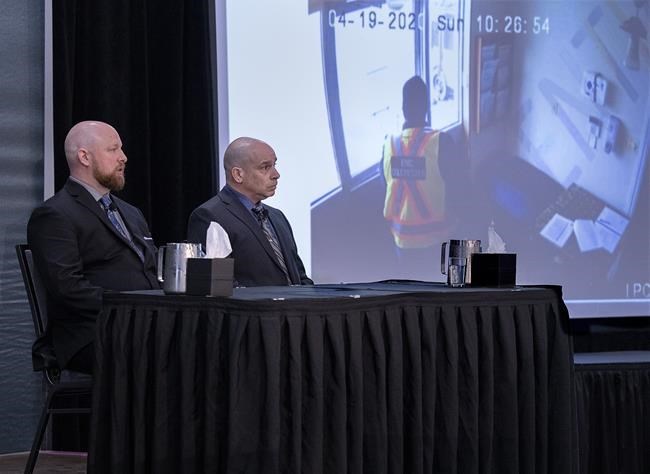HALIFAX — Two RCMP officers who mistakenly opened fire at a man outside a rural Nova Scotia firehall as they searched for a rampaging gunman said Thursday they believed they had found the shooter and defended their actions as consistent with their training.
Const. Terry Brown and Const. Dave Melanson made the assertion as they testified before the commission of inquiry into the mass shootings that claimed 22 lives over a 13-hour period on April 18-19, 2020.
“It’s a great benefit to go back and say if you knew this or you knew that,” said Melanson, who became emotional. “I didn’t have that benefit. I had a fraction of a second. On that day I gave my all.”
Brown said he believed he had identified a threat outside the firehall in Onslow, N.S., on the morning of April 19, based on the information he had about the shooter -- primarily that the suspect was wearing an orange reflective vest and driving a replica RCMP cruiser.
Both he and Melanson fired their RCMP-issue carbine rifles from about 88 metres away, striking the building along with a monument and a sign in front of it.
The pair had been searching for killer Gabriel Wortman, who was believed to be somewhere in the immediate vicinity. They stopped their unmarked car on the road near the firehall after observing an RCMP cruiser parked outside the building with a man in a vest standing near the vehicle. Both officers said they didn’t see RCMP Const. Dave Gagnon, who was sitting inside the car.
The man in a yellow and orange safety vest turned out to be David Westlake, the emergency management co-ordinator for Colchester County. The officers fired at Westlake, who ducked for cover and ran to safety inside the firehall.
“We came across a person that was identical to a description that we had — a guy in an orange reflective vest standing next to a police car,” Brown said. “All of my focus was on that person in the orange reflective vest.”
Brown said he believes the situation “translated exactly to training I’ve done.”
He added that he is sorry for what Westlake and three firemen who were in the building went through. He said he had no idea the firehall was being used as a comfort centre for people told to leave their homes in Portapique, N.S., where the killings had begun the night before.
“At the end of the day, it wouldn’t have changed my reaction,” said Brown. “I believed that person was going inside the building to kill people, and that’s why I engaged them the way I did.”
Documents previously released by the inquiry say Brown fired four rounds and Melanson fired one. Two of the rounds pierced one of the station’s garage doors and damaged a fire truck inside.
The pair were cross-examined by lawyer Michael Scott, who represents the families of 14 of the 22 victims.
Scott asked the officers whether they looked for the call sign that would have been on the side of the cruiser parked outside the firehall before firing their weapons, in order to compare it with the call sign known to be on the killer’s replica vehicle.
“My focus was on the person in the orange vest standing behind the police car on the driver’s-side door,” said Brown. “From the distance I was at, there was no way I could read that call sign.”
Brown also told Scott that he yelled commands to Westlake to show his hands, but he said the man ducked and didn’t comply.
Westlake, however, has told investigators that he didn’t hear that command and aside from gunshots only heard someone saying “Get down!”
Later Thursday, RCMP Const. Ian Fahie testified about the minutes after he arrived at the scene of the killings of Heather O’Brien and Kristen Beaton on Plains Road in the Debert area on the morning of April 19.
The constable said after he and his partner arrived, they attempted to take the pulse of O’Brien. He testified that moments later, an emergency medical response team member took over monitoring the woman.
Fahie said he brusquely told arriving firefighters to leave because of potential danger, and then, as he was monitoring the area with his carbine at the ready, O'Brien's daughter — Michaella Scott — also arrived.
In her interview last year with the commission, Scott said she was turned back by Fahie. "This day burns in the back of my head," she had stated. "They took away my right to hold my mother's hand, to say goodbye, to tell her I loved her one last time."
However, the constable testified on Thursday that while he had yelled at Scott to leave and had likely directed a profanity towards her, he had believed at the time there was still the potential for danger from the gunman.
“It was not safe for us. We were thinking an ambush scenario,” he said.
This report by The Canadian Press was first published May 5, 2022.
-- With files by Michael Tutton
Keith Doucette, The Canadian Press



